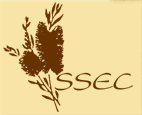 • Early Years
• Early Years
• Early Dwellings
• Village Life
• Commerce
• School Days
• Individuals
• Places of Worship
• Marton Park
• Community
|
The Village Grows Up |
Kurnell Individuals
Mention must be made of some special individuals who have contributed to Kurnell's history.
Claude Marquet was a well-known political cartoonist who expressed a radical philosophy and an idealistic view of the worker in his cartoons. In 1914 Claude and his wife Ann built a home at Kurnell. In April 1920 he and Harry Palmer (grocer of Kurnell) were returning to Kurnell in Claude's sailing boat, which was filled with household and shop supplies, when they were overwhelmed by a sudden squall. Their boat was discovered anchored in Botany Bay, still filled with groceries, but with no sign of life on board. Their bodies were never recovered. The boat was later auctioned.
In July 1920 a memorial book was published in Claude Marquet's honour. Proceeds of the sale were given to his widow. Many of his friends including Henry Lawson, then living in the Sutherland Shire at Como, penned memorials in the book. |
 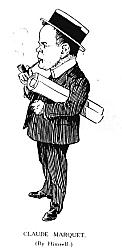 |
| No chronicle of Kurnell can be complete without mention of John Graham Weir. John and his wife settled permanently in a Kurnell fishing cottage. Turning his hand to many things, he fished, harvested seaweed, organically grew vegetables, milked cows for his neighbours and began a poultry farm, all the time working at the Bunnerong Power House and commuting on his BSA Bantam motor bike. |
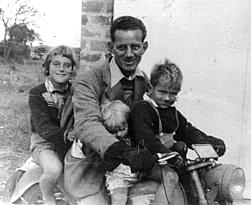
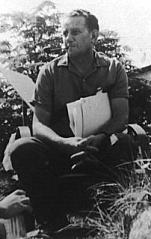 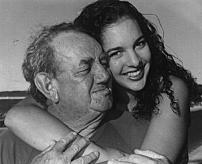 |
He later went to work as Public Relations Officer at AOR and threw himself into community work in his spare time. He wrote and produced the Kurnell Village Newsletter on an old gestetner copier and then personally delivered it. For more than 25 years he was President of the Kurnell Progress Association and involved in most other local community organisations. In 1970 he received Sutherland Shire Council's first Citizen of the Year Award, and in 1971 was further recognised with an MBE for his community work. From 1971 to 1974 he served as an Independent Councillor on the Council. As this book goes to press, the Kurnell Progress Association is dedicating a park for the community as the John Graham Weir Memorial Park. He died in March 1998.
Kurnell is home to some well-known and talented artists, such as Otto Kuster, whose works hang in galleries and homes throughout the world.
There were many 'characters' in the village. 'German Bob' lived on what was called Thieves Hill, in Polo Street, where he grew grapes and made wine, though he never drank himself. The locals exchanged fish and garden produce for the wine. Bob also distilled perfume from grevillea flowers, selling it in Sydney where he went to play his trombone in the Prince Edward Theatre.
'King George', who always walked around in a trench coat, was viewed as a rough diamond, but he appears never to have done anything but mind his own business, which was often simply fishing.
'Metho May' also lived on Thieves Hill. Everybody was terrified of her. She died doing a high dive off the bridge to Bare Island, La Perouseit was low tide and she had dived onto rocks! '
Little Freddie' claimed to have a birthday every weekend. He wore his old felt hat pulled down over his face and would always go down to meet the Sunday ferry. He walked among the visitors and said to them, "It's my birthday " . They would give him a few coins; so the little scoundrel saw to it that he did indeed have a birthday every weekend.He later went to work as Public Relations Officer at AOR and threw himself into community work in his spare time. He wrote and produced the Kurnell Village Newsletter on an old gestetner copier and then personally delivered it. For more than 25 years he was President of the Kurnell Progress Association and involved in most other local community organisations. In 1970 he received Sutherland Shire Council's first Citizen of the Year Award, and in 1971 was further recognised with an MBE for his community work. From 1971 to 1974 he served as an Independent Councillor on the Council. As this book goes to press, the Kurnell Progress Association is dedicating a park for the community as the John Graham Weir Memorial Park. He died in March 1998.
Kurnell is home to some well-known and talented artists, such as Otto Kuster, whose works hang in galleries and homes throughout the world.
There were many 'characters' in the village. 'German Bob' lived on what was called Thieves Hill, in Polo Street, where he grew grapes and made wine, though he never drank himself. The locals exchanged fish and garden produce for the wine. Bob also distilled perfume from grevillea flowers, selling it in Sydney where he went to play his trombone in the Prince Edward Theatre.
'King George', who always walked around in a trench coat, was viewed as a rough diamond, but he appears never to have done anything but mind his own business, which was often simply fishing.
'Metho May' also lived on Thieves Hill. Everybody was terrified of her. She died doing a high dive off the bridge to Bare Island, La Perouseit was low tide and she had dived onto rocks! '
Little Freddie' claimed to have a birthday every weekend. He wore his old felt hat pulled down over his face and would always go down to meet the Sunday ferry. He walked among the visitors and said to them, "It's my birthday " . They would give him a few coins; so the little scoundrel saw to it that he did indeed have a birthday every weekend. |
 |
Kurnell resident, Robert (Bob) Mackie, a journalist and cartoonist, wrote and published The Sentinel newspaper , Who's Who in Business in the Sutherland Shire, and Pacific Portal . In 1956 he wrote and published the Golden Jubilee of the Sutherland Shire from his Caringbah newspaper office. Mackie was an insatiable collector of unusual, nautical and Cook-related artifacts. So extensive was his collection that public-spirited Bob opened a museum in the 1940s near the Roman Catholic Church on Prince Charles Parade. He decorated the exterior of a shed with old oil company signs such as Mobil Pegasus, Standard Oil, Golden Fleece and Purr Pull. Inside his 'Captain Cook's Australian Museum' he had such items as Aboriginal weapons, early newspapers and cartoons, a series of British, German and Japanese helmets dating back more than 100 years, a "genuine Crusader's helmet 700 years old", and another which he reckoned to be a 1300 year old Roman helmet. There were newspaper clippings about Cook's voyages, memorabilia from the early days of the Sutherland Shire, and a model of the Endeavour . Bob offered to sell the museum to Sutherland Shire Council, which showed little interest, and the museum was taken over in 1958 by Stan Unwin, hitherto a dealer in old wares.
Unwin added to the collection and maintained the decrepit look of the building. He also extended it using flattened kerosene tins for the cladding. |
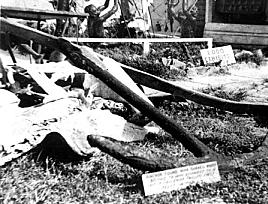 |
Even before one entered the property, it was said, "you got your money's worth by reading the signs". His charges: Single Adults 2 shillings; Man and Wife 3 shillings; Man, Wife, 1 children 3 shillings; Man Wife 2 children1 shilling and 6 pence. The more children you had the cheaper it became! A lateral thinker, he told a friend on the quiet that the shed and most of everything came from the tip; yet of anything that looked remotely nautical or doubtful he would say, "Yes that's definitely a Captain Cook relic!" He had all manner of specimensodd, unusual, unique, natural and not so naturalmostly displayed in glass jars. When the museum closed, the National Parks and Wildlife Service took its contents to the NPWS Discovery Centre for critical examination. The building, an eyesore, was then demolished and the land left vacant. |
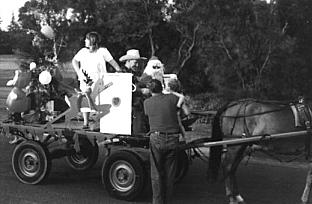 |
| top of page |
|
